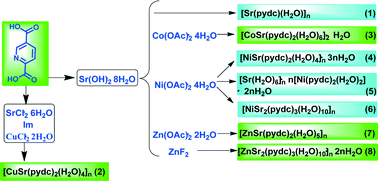a Key Laboratory of Organic Synthesis of Jiangsu Province, College of Chemistry, Chemical Engineering and Materials Science, Soochow University, Suzhou 215123, China
b Qinghai Institute of
c State Key Laboratory of Applied Organic Chemistry,
CrystEngComm 2014, 16, 1091-1102
The first series of heterometallic SrII–MII (M = Cu, Co, Ni and Zn) coordination polymers based on pyridine-2,5-dicarboxylic acid (H2pydc) are reported. Eight complexes of compositions, [Sr(pydc)(H2O)]n (1), [CuSr(pydc)2(H2O)4]n (2), [CoSr(pydc)2(H2O)6]2n·H2O (3), [NiSr(pydc)2(H2O)4]n·3nH2O (4), [Sr(H2O)6]n·n[Ni(pydc)2(H2O)2]·2nH2O (5), [NiSr2(pydc)3(H2O)8]n·2nH2O (6), [ZnSr(pydc)2(H2O)5]n (7) and [ZnSr2(pydc)3(H2O)10]n·2nH2O (8), have been prepared and characterized. The structures of the complexes could be controlled via rationally choosing the appropriate metal salts, adding the starting materials in different orders, and tuning the ratio of the starting materials. Eight varieties of structures, ranging from 1-D chains to 3-D networks, were obtained. The magnetic properties of 2, 3 and 6 were investigated from 2 K to 300 K. Antiferromagnetic MII

链接: //pubs.rsc.org/en/content/articlelanding/2014/ce/c3ce41975d#!divAbstract